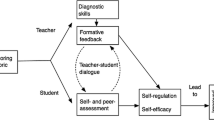Abstract
During 2007 all Danish university curricula were reformulated to explicitly state course objectives due to the adoption of a new Danish national grading scale which stipulated that grades were to be given based on how well students meet explicit course objectives. The Faculties of Science at University of Aarhus and University of Southern Denmark interpreted “course objectives” as “intended learning outcomes” (ILO) and systematically formulated all such as competencies using the SOLO taxonomy that operates with five numbered progressive levels of competencies. We investigate how the formulation of ILOs using the SOLO taxonomy gives information about competence progression, educational traditions, and the nature of various science subjects. We use all the course curricula (in total 632) from the two faculties to analyze and compare undergraduate and graduate courses within each department, and different departments with each other.









Similar content being viewed by others
References
Bauersfeld, H. (1979). Research related to the mathematical learning process. In International Commission on Mathematics Instruction, ICMI (Ed.), New trends in mathematics teaching (Vol. 4, pp. 199–213). Paris: UNESCO.
Biggs, J. B. (2003). Teaching for quality learning at university. Maidenhead: Open University Press.
Biggs, J. B., & Collis, K. F. (1982). Evaluating the quality of learning: The SOLO taxonomy, structure of the observed learning outcome. London: Academic Press.
Biggs, J., & Tang, C. (2007). Teaching for quality learning at university. Maidenhead: Open University Press.
Brabrand, C., & Dahl, B. (2008). ‘Constructive alignment and the SOLO taxonomy: A comparative study of university competences in computer science vs. mathematics’. Conferences in Research and Practice in Information Technology, 88, 3–17.
Dahl, B. (2008). International mobilitet med den nye danske karakterskala? MONA (Matematik- Og NAturfagsdidaktik), Vol. 4, No. 2 (June 2008), pp. 110–117.
Dahl, B., Lien, E., Lindberg-Sand, Å. (2009). Conformity or confusion? Changing higher education grading scales as a part of the Bologna process: The cases of Denmark, Norway, and Sweden. Accepted modulo revisions: Learning and Teaching: The International Journal of Higher Education in the Social Sciences. 2009 is likely publication year.
Danish Ministry of Education.(2004). Betænkning om indførelse af en ny karakterskala til erstatning af 13-skalaen. Betænkning nr. 1453, Karakterkommissionen. (Copenhagen: Ministry of Education). Retrieved October 18, 2007 from http://pub.uvm.dk/2004/karakterer/ .
Gall, M. D. (1970). The use of questions in teaching. Review of Educational Research, 40(5), 707–721.
Goodlad, J.I., Klein, M.F., & Tye, K.A. (1986). The domains of curriculum and Their study. (In B. B. Gundem (Ed.), Kompendium 3 Om læreplanpraksis og læreplanteori (pp. 31–64). Pedagogisk Forskningsinstitutt, University of Oslo) (Reprint of parts of Goodlad et al. (1979) book: Curriculum inquiry. New York: McGraw-Hill Book Company).
Lewis, K.G. (2007). Developing questioning skills. Center for Teaching Effectiveness, The University of Texas at Austin. Retrieved October 18, 2007, from http://www.utexas.edu/academic/cte/sourcebook/questioning.pdf.
Madsen, L.M., & Winsløw, C. (2008). Relations between teaching and research in physical geography and mathematics at research intensive universities. International Journal of Science and Mathematics Education, (April), 2008., Accepted. published online May 2008.
Oliver, D., Dobele, T., Greber, M., & Roberts, T. (2004). This course has a bloom rating of 3.9. Conferences in Research and Practice in Information Technology, 30, 227–231.
Oppenheim, A. N. (1992). Questionnaire design, interviewing and attitude measurement. London: Pinter.
Robson, C. (2002). Real world research. Oxford: Blackwell.
de Saussure, F. (1997). Deuxième cours de linguistique générale 1908–1909/Saussure’s second course of lectures on general linguistics 1908–1909. Oxford: Pergamon.
Skemp, R. R. (1987). The psychology of learning mathematics. London: Lawrence Erlbaum Associates Publishers.
Wittgenstein, L. (1991). Bermerkungen über die grundlagen der mathematik. Frankfurt am Main: Suhrkamp Taschenbuch Verlag.
Acknowledgments
The authors would very much like to thank Anne Mette Mørcke, Berit Eika, Gitte Wichmann-Hansen, John Biggs, and Catherine Tang for providing extensive and valuable feedback on our SOLO-classification of verbs. Also, thanks to Torben K. Jensen for interesting discussions about our analysis. Finally we also want to thank Gunnar Handal, Henrik Stetkær, and Jens Carsten Jantzen for various help and comments.
Author information
Authors and Affiliations
Corresponding author
Additional information
Full name: Bettina Dahl Søndergaard (Soendergaard).
The authors are listed in alphabetical order. They have contributed differently, but equally, to this paper.
‘Academic staff’ denotes all Assistant, Associate and Full professors.
Appendices
Appendix 1
The Danish “7-Steps Grading Scale”
The new grading scale reflects the European Credit Transfer and Accumulation System (ECTS; Dahl et al. 2009). See Table 1.
Appendix 2
See Table 2.
Appendix 3
The data for the entire analysis is available online (in browseable XML format) here, in Danish: see Table 3.
Appendix 4
The figure shows the number of undergraduate courses plus the number of graduate courses in our data set at both universities. The final data set consisted of a total of 632 courses: see Table 4.
Rights and permissions
About this article
Cite this article
Brabrand, C., Dahl, B. Using the SOLO taxonomy to analyze competence progression of university science curricula. High Educ 58, 531–549 (2009). https://doi.org/10.1007/s10734-009-9210-4
Received:
Accepted:
Published:
Issue Date:
DOI: https://doi.org/10.1007/s10734-009-9210-4




